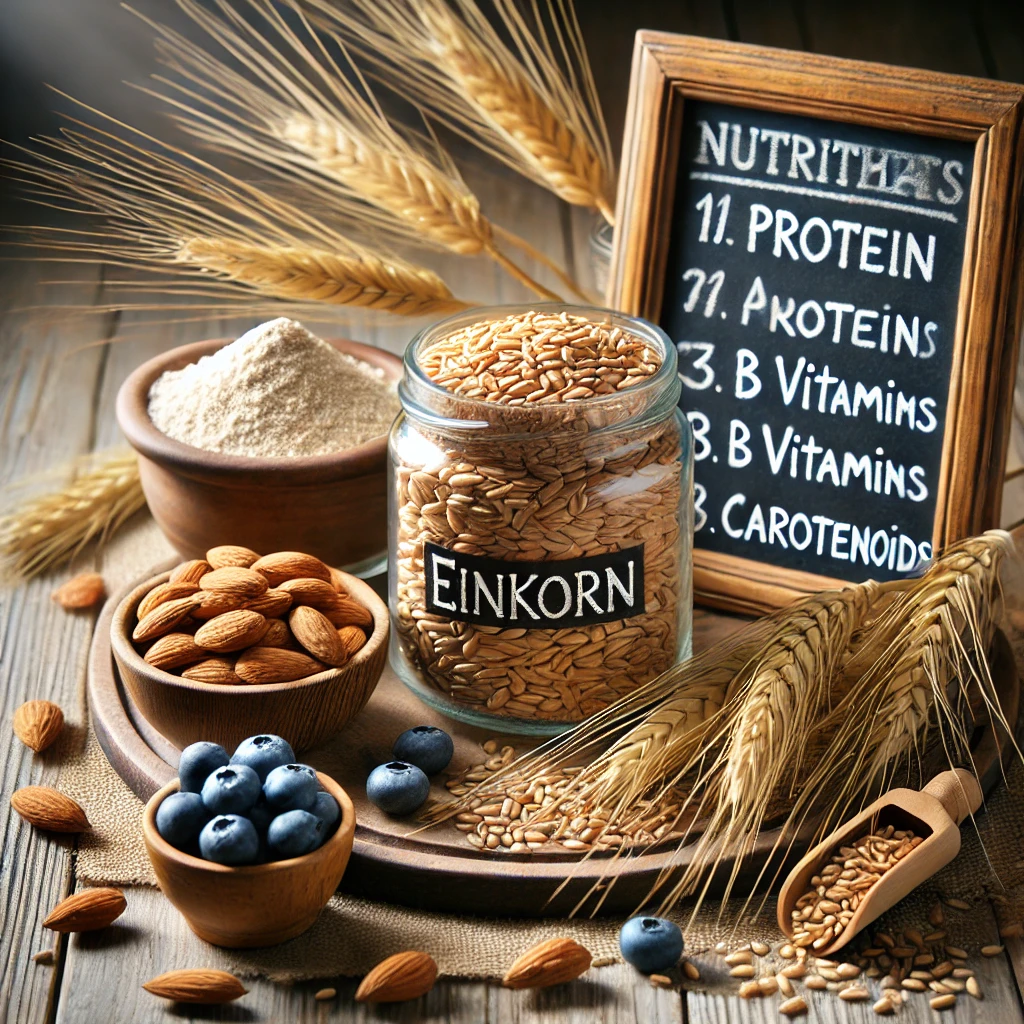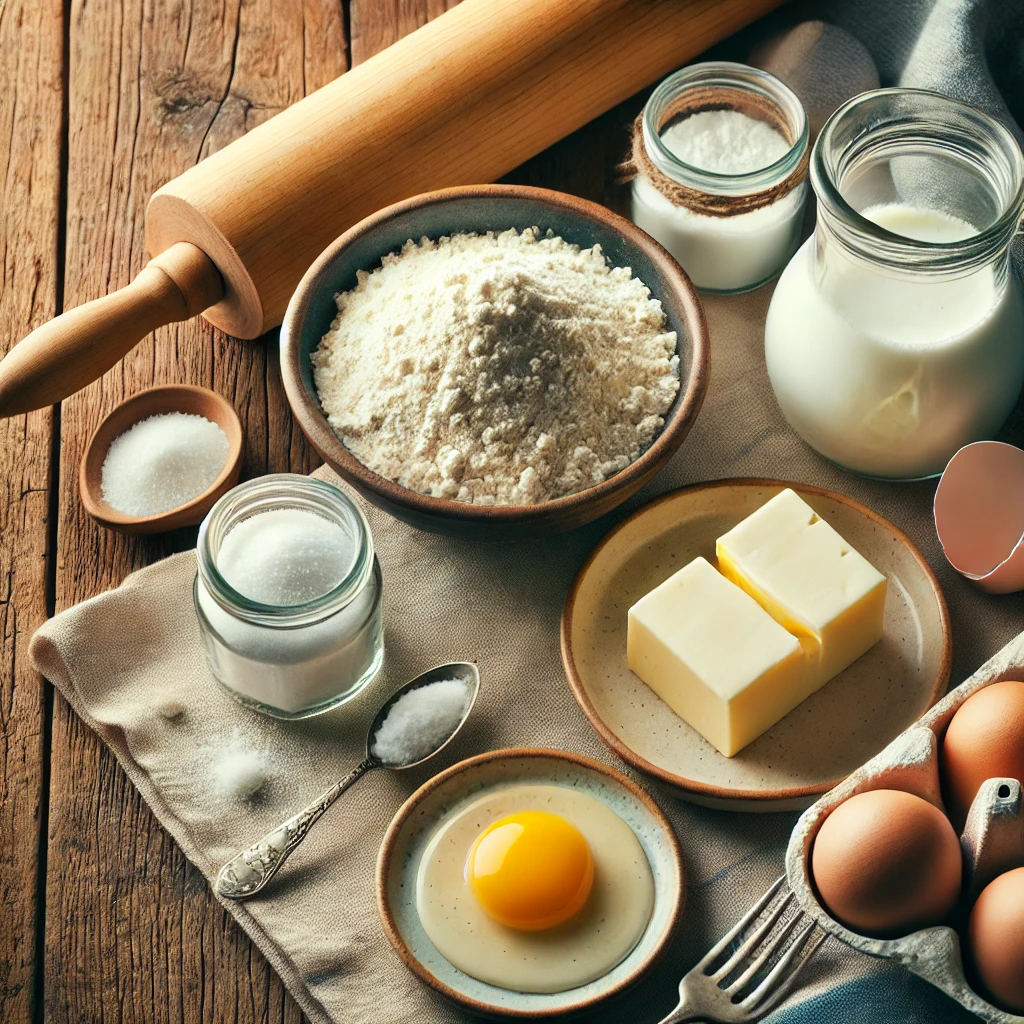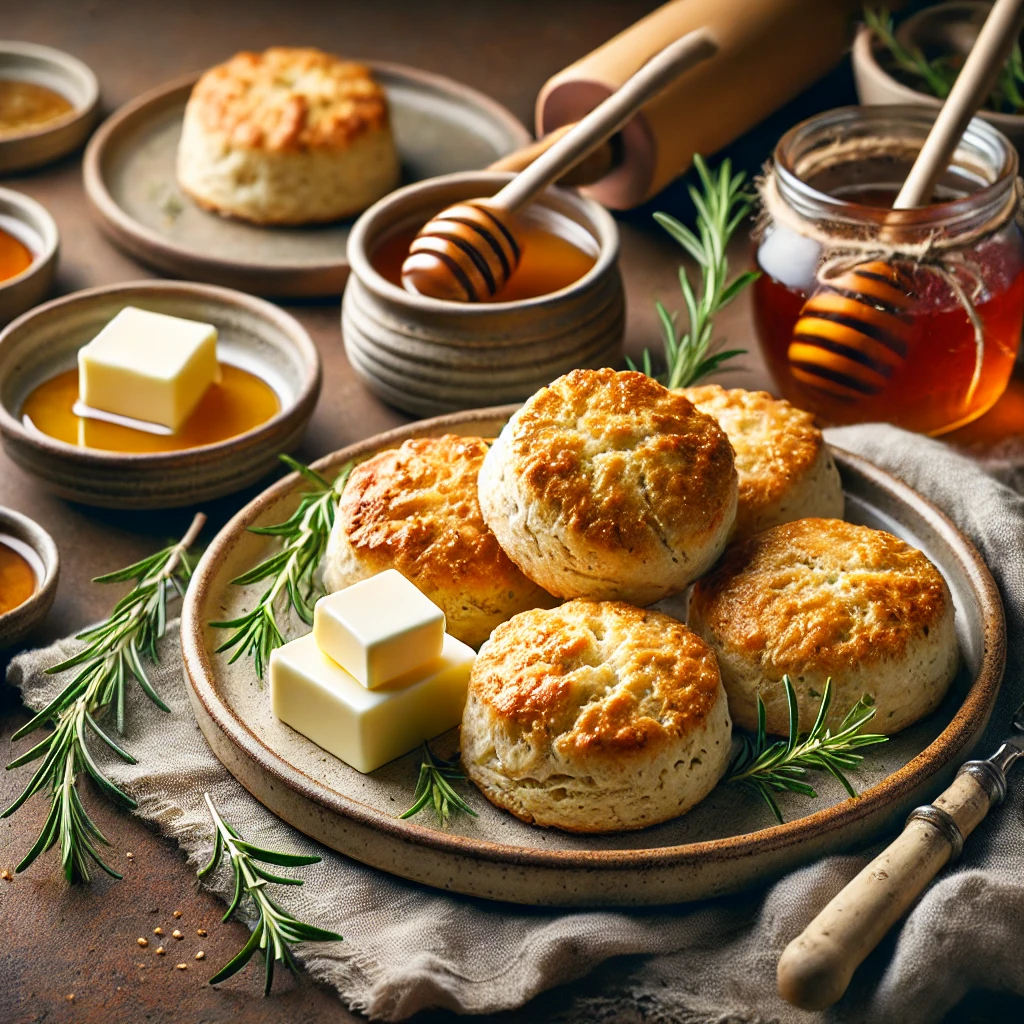Table of Contents
ToggleIntroduction
In recent years, there has been a growing appreciation for heritage grains, ancient varieties of wheat and other cereals that have remained largely untouched by modern agricultural practices. Among these, Einkorn stands out as one of the oldest and most nutritious grains, offering a connection to our ancestors and a healthier alternative to modern wheat.
Einkorn, which dates back more than 10,000 years, is prized for its nutty flavor, high nutritional value, and digestibility. Its unique gluten structure makes it an excellent choice for baking, particularly for those who may struggle with conventional wheat. Today, we’ll explore the beauty of Einkorn and how to create the perfect flaky and tender Einkorn biscuit. Let’s dive into the details of restoring this ancient grain to our tables!
What Are Heritage Grains?
Definition and Significance
Heritage grains are ancient varieties of wheat and cereals that have retained their original genetic makeup, untouched by the hybridization and genetic modifications common in modern agriculture. They include Einkorn, Emmer, Spelt, and others. These grains are not only a part of our agricultural history but also a solution for healthier eating and sustainable farming.
How Heritage Grains Differ from Modern Wheat
Modern wheat has been selectively bred for higher yields, uniformity, and ease of processing. Unfortunately, this has often come at the cost of nutrition and digestibility. Heritage grains like Einkorn contain:
- Higher protein content.
- More vitamins and minerals, such as B vitamins and iron.
- A simpler gluten structure, which many find easier to digest.
Unlike modern wheat, these grains retain their natural complexity and depth of flavor, offering a superior alternative for health-conscious bakers.
Why They’re Making a Comeback
The return to heritage grains is fueled by trends in sustainable living, health awareness, and culinary exploration. People are seeking foods that:
- Support biodiversity.
- Promote gut health with fewer processed elements.
- Reconnect us to traditional farming practices.
Why Einkorn is a Star Heritage Grain
The History of Einkorn
Einkorn, derived from the German term for “one-grain,” is believed to be the earliest domesticated form of wheat. It was cultivated in the Fertile Crescent and thrived in challenging environments. For centuries, Einkorn sustained ancient civilizations before being replaced by higher-yield crops.
Nutritional Benefits of Einkorn
Einkorn is a powerhouse of nutrients, boasting:
- Higher levels of protein and antioxidants than modern wheat.
- Rich in carotenoids, which contribute to eye health.
- Easier digestibility due to its simple gluten structure, making it suitable for individuals with mild gluten sensitivities (though it is not gluten-free).

Flavor and Texture in Baking
Einkorn’s nutty, slightly sweet flavor is unparalleled. Its fine texture creates baked goods that are tender and flavorful. When used in biscuits, Einkorn lends a light, flaky crumb that modern wheat simply cannot replicate.
Baking with Einkorn: What You Need to Know
Adjusting Recipes for Einkorn
Einkorn flour behaves differently than modern wheat flour. Key differences include:
- Hydration: Einkorn absorbs less water, so doughs may feel wetter.
- Stickiness: The simpler gluten structure makes the dough more delicate.
- Kneading: Overworking the dough can lead to dense results, so a gentle touch is critical.
Tips for Success in Einkorn Baking
- Start with trusted recipes specifically designed for Einkorn.
- Avoid overmixing the dough to preserve its lightness.
- Use cold ingredients, especially butter, to create the best texture.
- Allow the dough to rest briefly to improve handling.
The Perfect Einkorn Biscuit Recipe
Ingredients You’ll Need
To create tender, flaky Einkorn biscuits, gather the following ingredients:
- 2 cups of Einkorn flour
- 1 tablespoon baking powder
- 1 teaspoon salt
- 6 tablespoons cold, unsalted butter (cubed)
- ¾ cup whole milk or cream

Step-by-Step Instructions
- Prepare the Dry Ingredients
In a large mixing bowl, whisk together Einkorn flour, baking powder, and salt. This ensures even distribution of the leavening agent. - Cut in the Butter
Add cold, cubed butter to the flour mixture. Use a pastry cutter or your fingertips to work the butter into the flour until the mixture resembles coarse crumbs. - Add the Milk
Gradually pour in the milk while stirring gently with a fork. Stop mixing as soon as a sticky dough forms. - Shape the Dough
Transfer the dough onto a floured surface. Lightly knead it just enough to bring it together. Pat it into a 1-inch-thick round. - Cut the Biscuits
Use a biscuit cutter to cut rounds from the dough. Re-roll scraps gently if needed. - Bake
Arrange the biscuits on a parchment-lined baking sheet, leaving space between them. Bake at 425°F (220°C) for 12–15 minutes, or until golden brown. - Serve and Enjoy
Remove from the oven and serve warm with butter, honey, or your favorite jam.
Ingredient Breakdown: Why Each Item Matters
Einkorn Flour
The star of the recipe, Einkorn flour provides a nutty flavor and delicate texture. Its nutritional value and digestibility make it ideal for biscuits. Substituting modern wheat flour may alter the flavor and texture.
Butter
High-quality, cold butter ensures flakiness and rich flavor. The cold temperature helps create air pockets during baking, resulting in a light texture.
Milk or Cream
The liquid binds the dough and contributes to its softness. Cream adds a luxurious richness, while milk offers a more subtle profile.
Customizing Your Einkorn Biscuits
Savory Additions
For a savory twist, consider mixing in:
- Chopped herbs like rosemary or thyme.
- Shredded cheese such as cheddar or Parmesan.
- Crumbled cooked bacon or sun-dried tomatoes.
Sweet Variations
To create sweet biscuits, you can add:
- A tablespoon of honey or maple syrup.
- Cinnamon and a handful of dried fruits.
- A sprinkle of coarse sugar on top before baking.
Common Mistakes and How to Avoid Them
Overmixing the Dough
Overmixing develops the gluten too much, leading to tough biscuits. Handle the dough gently and stop mixing once it comes together.
Incorrect Oven Temperature
Baking at too low a temperature can result in flat, undercooked biscuits. Preheat your oven to ensure a strong rise.
Substituting Flours Incorrectly
Einkorn has unique properties that modern wheat doesn’t share. Substituting other flours without adjustments may lead to disappointing results.
Serving Suggestions for Einkorn Biscuits
Perfect Pairings
Einkorn biscuits pair beautifully with:
- Soups and stews for a comforting meal.
- Scrambled eggs and sausage for a hearty breakfast.
- Fresh fruit and whipped cream for a dessert option.
How to Store and Reheat
- Store biscuits in an airtight container for up to 3 days.
- Reheat in a 350°F (175°C) oven for 5–7 minutes to revive their texture.
Why Restoring Heritage Grains Matters
Health Benefits
Heritage grains like Einkorn support better digestion, improved nutrient absorption, and offer a more balanced diet.
Environmental Impact
Cultivating heritage grains promotes biodiversity, soil health, and sustainable farming practices, helping to preserve the planet for future generations.
Final Thoughts on Baking with Einkorn
Exploring heritage grains is more than a culinary adventure—it’s a step toward honoring tradition and embracing sustainability. Baking with Einkorn not only enhances your meals but also connects you to a rich agricultural history. Try this Einkorn biscuit recipe, and discover how a simple grain can transform your baking.
FAQs
- What is Einkorn flour, and where can I buy it?
Einkorn flour is the oldest form of wheat. Look for it in specialty grocery stores or online. - Can I substitute Einkorn with regular flour?
Yes, but adjustments will be needed as Einkorn behaves differently. - Why is Einkorn dough stickier than regular dough?
Its simpler gluten structure absorbs less liquid, resulting in a stickier dough. - Are Einkorn biscuits gluten-free?
No, Einkorn contains gluten, though it is easier to digest for some. - What other recipes can I make with Einkorn flour?
Einkorn flour is versatile and works well in pancakes, muffins, bread, and pasta.
Customizing Your Einkorn Biscuits
Einkorn biscuits provide an excellent base for creativity. By tweaking the recipe, you can craft both savory and sweet versions to suit different occasions and palates.
Savory Additions
If you love biscuits as a complement to savory dishes, consider these delicious mix-ins:
- Cheese: Add shredded cheddar, Gruyere, or Parmesan for a cheesy biscuit that pairs perfectly with soups and stews.
- Herbs: Fresh or dried herbs like rosemary, thyme, or chives add an earthy, aromatic touch.
- Spices: A pinch of garlic powder, smoked paprika, or black pepper can elevate the savory flavor profile.
- Veggies: Finely diced jalapeños, sundried tomatoes, or caramelized onions work beautifully for an elevated side dish.
- Meats: Crumbled bacon or pancetta creates a rich and smoky addition.
Sweet Variations
For sweeter versions, try the following:
- Natural Sweeteners: Add honey, maple syrup, or coconut sugar to the dough for a touch of sweetness.
- Spices: A teaspoon of cinnamon or nutmeg adds warmth and depth.
- Fruits: Mix in dried fruits like cranberries, chopped dates, or raisins for a burst of flavor.
- Toppings: Sprinkle coarse sugar or brush the tops with a honey glaze before baking to create a caramelized crust.
The versatility of Einkorn biscuits ensures there’s a version for everyone, whether you’re serving them for breakfast, dinner, or dessert.
Common Mistakes and How to Avoid Them
Mastering the perfect Einkorn biscuit can be tricky for first-time bakers. Here are the most common pitfalls and how to sidestep them:
Overmixing the Dough
Overmixing is the number one culprit for tough, dense biscuits. Einkorn’s delicate gluten structure means that less mixing is better. Stop as soon as the dough comes together, even if it looks slightly uneven.
Ignoring Hydration Differences
Einkorn absorbs less liquid than modern wheat. Using too much liquid can result in overly sticky dough, making it hard to shape and leading to a dense final product. Add milk or cream gradually, stopping once the dough feels workable.
Using Warm Ingredients
Cold butter and milk are crucial to achieving flaky layers. Warm ingredients melt the butter prematurely, resulting in a heavier, less airy texture.
Improper Oven Temperature
Biscuits need high heat to rise properly and develop a golden crust. Always preheat your oven to 425°F (220°C). Using an oven thermometer ensures accuracy, as even slight temperature differences can impact the outcome.
Substituting Flours Incorrectly
Einkorn is unique, and substituting it with modern wheat or other flours requires adjustments in hydration and handling. Stick with Einkorn to enjoy its distinctive flavor and texture.
Serving Suggestions for Einkorn Biscuits
Einkorn biscuits are a versatile addition to any meal. Here’s how to enjoy them at their best:
Perfect Pairings
- Breakfast: Serve warm with scrambled eggs, crispy bacon, or sausage gravy for a hearty start to the day.
- Soups and Stews: Pair them with creamy soups like tomato, butternut squash, or chicken pot pie.
- Afternoon Snack: Top with clotted cream and jam for an elegant tea-time treat.
- Dessert: Use them as a base for shortcakes, layered with fresh berries and whipped cream.

How to Store and Reheat
To keep your biscuits fresh and flavorful:
- Storing: Place cooled biscuits in an airtight container. They will stay fresh for up to three days at room temperature.
- Freezing: Wrap individual biscuits in plastic wrap and store in a freezer bag for up to three months. Thaw overnight in the refrigerator before reheating.
- Reheating: Warm biscuits in a 350°F (175°C) oven for 5–7 minutes to restore their original texture.
Why Restoring Heritage Grains Matters
Restoring heritage grains isn’t just a trend; it’s a movement toward a healthier and more sustainable future. Einkorn, in particular, exemplifies why these grains deserve a prominent place in our kitchens.
Health Benefits
Einkorn flour offers:
- Better Digestibility: Its simple gluten structure is gentler on the digestive system, making it suitable for those with mild gluten sensitivities.
- Higher Nutritional Content: Rich in protein, fiber, and essential vitamins like B6, Einkorn supports overall health.
- Lower Glycemic Index: Einkorn has a more stable effect on blood sugar levels, making it ideal for managing energy throughout the day.
Environmental Impact
Modern farming techniques prioritize yield over sustainability, often depleting soil health and reducing biodiversity. Heritage grains like Einkorn:
- Support Sustainable Farming: They thrive in poor soils and require fewer chemical inputs.
- Preserve Biodiversity: Cultivating these grains protects the genetic diversity of crops.
- Combat Climate Change: Heritage grains are more resilient to environmental stressors, making them vital in adapting to a changing climate.
By incorporating Einkorn into your baking, you’re contributing to a larger effort to protect our planet and promote healthier eating.
Final Thoughts on Baking with Einkorn
Baking with Einkorn is an enriching experience that goes beyond making delicious biscuits. It’s about reconnecting with the past, embracing healthier choices, and supporting sustainable practices. As you experiment with Einkorn flour, you’ll discover its versatility and the unique character it brings to recipes.
From its ancient history to its modern-day applications, Einkorn truly embodies the spirit of restoration and innovation. Whether you’re making flaky biscuits, hearty bread, or tender pastries, this heritage grain deserves a place in your pantry.
FAQs
- What is Einkorn flour, and where can I buy it?
Einkorn flour is the oldest form of wheat, known for its nutty flavor and nutritional value. It’s available at health food stores, specialty grocers, and online. - Can I substitute Einkorn flour for all-purpose flour?
Yes, but adjustments are needed. Einkorn absorbs less liquid, so reduce the amount of water or milk in your recipe. - Are Einkorn biscuits gluten-free?
No, Einkorn contains gluten, but its simpler structure makes it easier to digest for some people. - How do I store Einkorn flour?
Store Einkorn flour in an airtight container in a cool, dry place. For long-term storage, refrigerate or freeze it to maintain freshness. - What makes Einkorn different from modern wheat?
Einkorn has higher protein, simpler gluten, and more nutrients than modern wheat, making it a healthier choice. - Can I use Einkorn flour for other baked goods?
Absolutely! Einkorn works well for bread, pancakes, muffins, and cookies. - Why does Einkorn dough feel sticky?
Its gluten structure and lower water absorption make the dough naturally stickier. Use a light touch when handling it. - What liquids work best with Einkorn?
Whole milk, cream, or buttermilk are ideal for enhancing the texture and flavor of Einkorn biscuits. - Can I make Einkorn biscuits vegan?
Yes! Substitute butter with plant-based alternatives and milk with almond or oat milk. - Why are heritage grains important for sustainability?
They support biodiversity, require fewer resources, and thrive in challenging climates, promoting sustainable agriculture.

